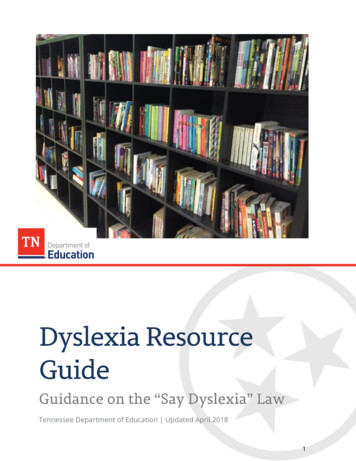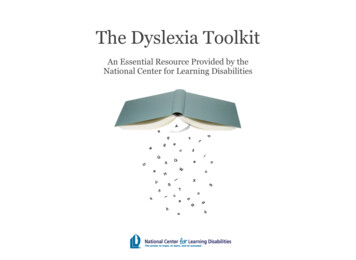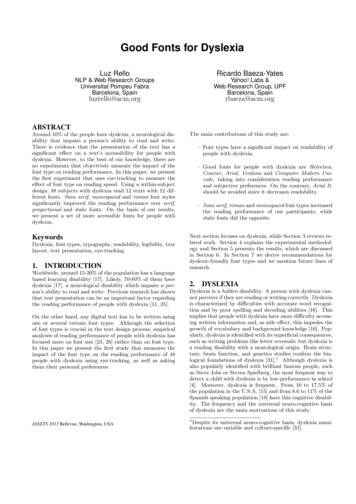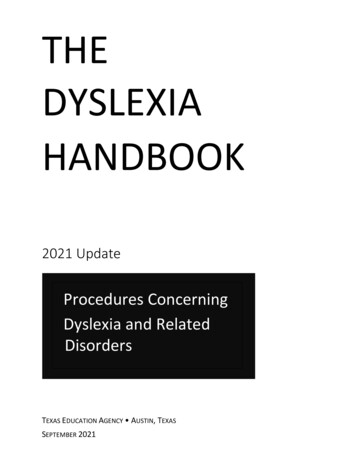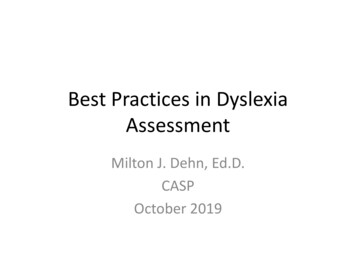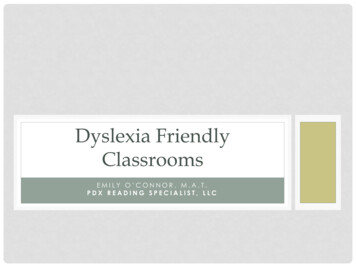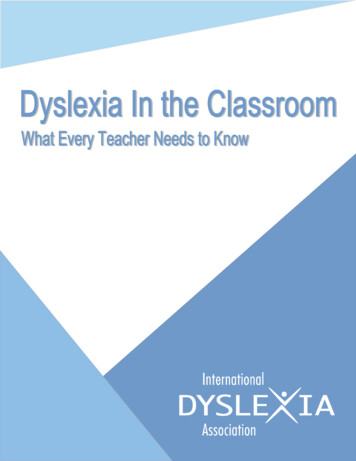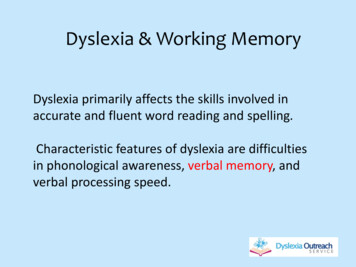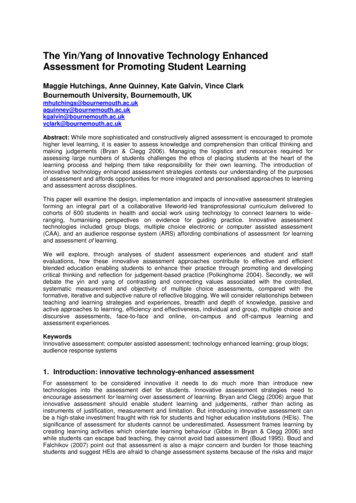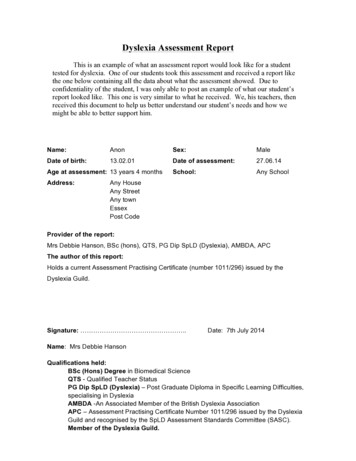
Transcription
Dyslexia Assessment ReportThis is an example of what an assessment report would look like for a studenttested for dyslexia. One of our students took this assessment and received a report likethe one below containing all the data about what the assessment showed. Due toconfidentiality of the student, I was only able to post an example of what our student’sreport looked like. This one is very similar to what he received. We, his teachers, thenreceived this document to help us better understand our student’s needs and how wemight be able to better support him.1 Church Green, Roxwell, Chelmsford CM1 4NZ Tel: 07935 924 466 E: info@clarity.co.uk www.clarityassessments.co.ukName:AnonSex:MaleDate of birth:13.02.01Date of assessment:27.06.14School:Any SchoolAge at assessment: 13 years 4 monthsAddress:Any HouseAny StreetAny townEssexPost CodeProvider of the report:Mrs Debbie Hanson, BSc (hons), QTS, PG Dip SpLD (Dyslexia), AMBDA, APCThe author of this report:Holds a current Assessment Practising Certificate (number 1011/296) issued by theDyslexia Guild.Signature: .Date: 7th July 2014Name: Mrs Debbie HansonQualifications held:BSc (Hons) Degree in Biomedical ScienceQTS - Qualified Teacher StatusPG Dip SpLD (Dyslexia) – Post Graduate Diploma in Specific Learning Difficulties,specialising in DyslexiaAMBDA -An Associated Member of the British Dyslexia AssociationAPC – Assessment Practising Certificate Number 1011/296 issued by the DyslexiaGuild and recognised by the SpLD Assessment Standards Committee (SASC).Member of the Dyslexia Guild.
ContentsPageSummary3Background Information6Analysis of ResultsVerbal Ability9Visual Ability10General Ability11AttainmentsReading11Spelling and writing12Cognitive ProcessingProcessing speed13Phonological ults table23Graph of results24Glossary26Tests used27
SummaryWhen assessing for Specific Learning Difficulties (SpLD), we assess three mainareas; Underlying Ability (potential to learn) Attainments (performance in reading, spelling etc.) Cognitive skills necessary to learn and retain information (memory,processing speed etc.)Where necessary, co-occurring learning difficulties are further explored usingchecklists, questionnaires and observations.Below is a summary of my findings, following which is further detailed analysis ofANON’s performance on each subtest, with a description of what has been tested. Atable of results, a chart of ANON’s profile and a glossary can also be found in theappendices and may be referred to whilst reading the report. For the purpose of thisreport, evaluations of ANON’s scores on each subtest are based on comparingconfidence intervals to the average range for his age, to identify areas of strengthsand weaknesses, and to the range of 95% confidence intervals for his Verbal Ability,as measured by the WRIT scores range 72-124. Non-intersecting confidence rangesindicate that scores are markedly different at the 95% confidence level andrepresent discrepancies worthy of note.1. General Underlying Ability – WRIT TestANON has high average word knowledge, significantly higher than his other scoresof underlying ability. This is an area of strength for ANON’s. He has average abilityto identify and use analogy and visual problem solving skills. ANON’s visuo-spatialmanipulation skills are below average for his age and an area of weakness for him.As is common with children with specific learning difficulties (SpLD), ANON’s scoresshowed statistical differences between them. The strengths and weaknessesdescribed in his Verbal subtests would be ‘averaged out’ if a Verbal Abilitycomposite score was used, therefore I have not included it in my report. It is alsoinadvisable to use his General Ability composite score, which comprises of hisVerbal and Visual Abilities hence this has also not been included.
2. AttainmentsReading: ANON has achieved average word reading and passage comprehension.However, to achieve this he needs to read at a below average rate. His passagereading accuracy and fluency are also below average to low average. ANON’sdifficulties accessing text mean that he will need, and is eligible to apply for, a readerin examinations and lessons.Spelling and writing: ANON’s spelling skills are low average and his writing speedplaces him on the cusp of being eligible for a scribe or using a laptop with the spellcheck disabled in examinations. In a test of free writing, 15% of the words areillegible and 9% spelt incorrectly. This does not involve the use of technicalvocabulary; his writing for school is therefore likely to contain more errors than this.His free writing omits most of the punctuation and he uses very long sentencesjoined with ‘and’ and ‘but’. In a test of fast copying, ANON scored below average;further evidence of the need for assistance recording his work. I would recommendan on-screen reader and use of a laptop to become his usual way of working inlessons and homework leading up to examinations, as he is more likely to be able to‘keep up’ with the high literacy demands this way and learn more subject knowledgerather than being fully occupied trying to cope with reading and writing. It will alsoenable him to become much more independent in his studies than relying uponfellow students / parents / teachers to read or spell words for him. Indeed, manystudents are reluctant to ask for, or accept such help during secondary school forfear of ridicule and therefore do not have the support they require.3. Tests of cognitive processingProcessing speed: ANON has average symbolic processing speed. When workingwith letters, his phonological processing speed, which is average for his age, is alittle faster than when working with digits, which is below average for his age.ANON’s below average phonological processing speed means that he is eligible toapply for 25% extra time in coursework and examinations.Phonological awareness: ANON’s overall phonological awareness skills are belowaverage for his age. His ability to identify a target sound in a word was much moredeveloped than his ability to manipulate sounds in words and particularly to blendsounds into words. These skills are necessary in the development of reading and
spelling; therefore, weaknesses in these skills could be responsible for the persistentdifficulties that ANON has faced developing accurate, fluent Literacy skills.Furthermore, ANON’s ability to read purely using the phonological route rather thanreading by sight is very underdeveloped for his age and illustrates the difficulty hefaces when confronting unfamiliar words. In senior school a student is required toread subject specific technical vocabulary and ANON is likely to struggle with thisduring lessons and importantly in reading examination questions if not supported.Memory: ANON’s verbal memory is below average to low average when testedusing digits, letters and recall of nonsense words. He is likely to find it difficult toretain information given orally in lessons without visual and kinaestheticreinforcement. His working memory varies depending on the stimulus. ANON ismore able to hold and manipulate letters (average for his age) than digits (belowaverage) and there is a marked discrepancy between the scores. This, coupled withhis marginally slower processing speed for digits, may present as increased difficultyconcentrating and not losing track in subjects relying more on digits than letters, forexample in Mathematics.4. Co-occurring difficultiesFrom the information supplied on the school and family questionnaires, the preassessment interview with ANON and Mr and Mrs ANON, my observations of ANONbefore, during and after assessment, do not lead me to believe that other cooccurring learning difficulties are present. I have therefore not investigated areas ofauditory processing, attention deficit or coordination difficulties further than what isalready covered in my assessment and explained in this report.ConclusionANON presents with many of the features associated with dyslexia; below averagephonological awareness and manipulation skills, below average verbal memory(digits), low average working memory (digits) and below average phonologicalprocessing speed (digits). He also has been observed to struggle sequencinginformation across 3 subtests. However, his marked discrepancy between his verbalunderlying ability subtests mean that the range of his verbal skills is wide and theconfidence intervals reach into the ‘below average’ range, standard score 72. Many
of his cognitive processing skills and attainments are within this range and wouldtherefore be considered appropriate for him. Although ANON’s profile containsdyslexic features when compared to expectations for children the same age as him,it is not consistent with a diagnosis of dyslexia.The following is a detailed, confidential, full assessment report. Please refer toAppendix 1 where there is a table of results, a chart interpreting ANON’sscores and learning profile and a glossary whilst reading the report.
Background InformationBackground information for this report has been obtained through pre-assessmentfamily and school questionnaires, as well as discussion with ANON and Mr and MrsANON during the pre-assessment and post-assessment interviews.Referral InformationIt was a pleasure to meet ANON and his parents today. He described his pastimesof computer games with friends, administering first aid as a qualified first aider withSt John’s ambulance for events and playing with his dog in the garden. ANONpresented as a polite boy with very well developed interpersonal skills for his age.He conversed with me openly.ANON has attended his current school for two years. Mrs ANON reported thatANON likes Science and ICT but dislikes Art, English and languages. She noticedANON’s difficulties with reading, spelling and handwriting at age 7 and stated thatANON’s writing can be very messy and inconsistent. Mrs ANON stated that ANONdoes not have additional support at school. His health is good and he has noallergies. Mrs ANON stated that ANON’s physical skills were satisfactory. His visionskills were tested during the early years and he was found to need spectacles, whichhe wore between the ages of 3 ½ and 6 ½ years. ANON also wore a patch to correcta lazy eye as a young child and after his eyes were re-tested during primary school,it was found that he no longer needs to wear spectacles. ANON’s hearing skills werealso tested at primary school and reported by Mrs ANON to present no concerns.Mrs ANON stated that she is not concerned about ANON’s memory skills,concentration or emotional behaviour. She reported that he is coping well both inand out of school. Mrs ANON’s main concerns are with ANON’s spelling, reading,writing and self-image.Teachers at ANON’s school state that he has settled well into school and describehis effort as ‘excellent’ in English; however, spelling was reported by teachers tohave been mentioned in some of his reports as needing improvement. He isenthusiastic and works well; he is cooperative, responsive and friendly. ANONmoved up from the lowest Literacy set in English at the beginning of year 8, due to
his positive attitude to work and his progress. ANON is in a class with a LearningSupport Assistant (LSA) who can assist him if he states that he requires help. Theyreport that he has no ‘behaviour points’ and is therefore well behaved at school.When he transferred from Primary school, he was not listed as having specialeducational needs.The reason for this assessment is for ANON and Mr and Mrs ANON to determinewhether or not he has a specific learning difficulty, such as dyslexia. Mr and MrsANON would also like some recommendations as to how to best help ANON athome and school.Test ConditionsThe interview room was light and airy. ANON was offered a rest break, which hetook following the passage reading test. From the information supplied throughANON’s questionnaire, he is not taking any regular medication that could interferewith this assessment and does not have any allergies. He is reported to be well.ANON appeared to be trying his best throughout the assessment. He conversed asexpected and had no difficulty following verbal instructions once practice items hadbeen administered. Therefore it is believed that the findings below are accurate andreliable.
Analysis of ResultsFull names of tests are included in the References Section in Appendix 3.1. Underlying AbilityVerbal / language skillsWRIT Subtest - AnalogiesThis test measures an individual’s understanding of oral language, particularlyabstract verbal concepts, and the ability to generalise their meaning to find a word tocomplete the analogy. Sentences were presented orally for ANON to complete bysupplying a missing word. ANON was calm and confident as he completed thequestions. He made suitable suggestions when he did not know the answers. ANONscored an average standard score of 91. His ability to identify and use analogy isaverage for his age.WRIT Subtest - VocabularyThis is a verbal measure of comprehension and reproduction of oral language.Words were presented, which ANON must define as precisely and accurately aspossible. ANON provided many complete definitions of words, scoring full marks formany of the items. He was willing to provide suitable attempts when he did not knowthe answers. At times, he made grammatical errors with his speech, such as “ apiece of money what is made of metal.” ANON scored a high average standardscore of 111; his word knowledge is high average for his age and being statisticallyhigher than his Analogy subtest score at the 0.05 level of significance*, is an area ofstrength for ANON. (*This means that there are only 5 chances in a hundred that thisscore was achieved by chance and it is therefore likely to be a distinguished area ofreal strength in his learning profile.)Summary of Verbal / Language skillsVerbal (Crystallised) intelligence is a measure of verbal information, acquired skills,and knowledge and relies heavily on exposure to formal education, Western cultureand the English language. ANON’s subtests scores were statistically different at the0.05 level; therefore, combining them into a composite score will mask his high andrelatively lower scores and not be useful. However, his verbal skills are average to
high average, with no areas of weakness, and should therefore provide him with asound basis upon which to build his Literacy skills.Non-verbal (Visuo-spatial) skillsWRIT Subtest - MatricesThis test measures visual problem solving, using a series of pictures. The picture,which fits most appropriately with them, must be selected from the ones supplied.This was the first subtest presented to ANON. ANON worked calmly and confidently.He scored an average standard score of 97. His visual problem solving skills areaverage for his age.WRIT Subtest - DiamondsThis measures spatial, manipulative skills and requires ANON to construct theillustrated form from diamond shaped pieces. ANON tried to construct the shapesbut found it difficult to line up the pieces, which meant that on one occasion he couldnot complete the shapes within the time allowed. He also tended to complete shapessimilar to the target, but not accurately. On one occasion, his attempt was veryunlike the target shape and he did not seem to be aware of this. ANON scored abelow average standard score of 84 for this test, his lowest subtest score. ANONhas underdeveloped visual spatial manipulation skills, compared to his othermeasures of underlying ability. This is likely to be a reason for his weakly formedhandwriting and could be also due to subtle visual difficulties detectable by anoptometrist.Summary of Non-verbal (Visuo-spatial) skillsNon-verbal or Visual (fluid) intelligence is a measure of Visual Underlying Abilitiesthat are more individual to the participant and less culturally influenced than Verbal(Crystallised) intelligence. ANON’s visual problem solving skills are average for hisage but his performance on spatial construction tasks is below average for his age.His composite Visual Ability is a low average standard score of 89.
Summary of General Underlying AbilityThis measure converts both Verbal and Visual underlying ability scores into oneGeneral Ability standard score. However, since there were statistically significantdifferences between ANON’s Analogies, Vocabulary and Diamonds subtest scores,his composite General Ability standard score (Performance IQ) is consideredunreliable and has therefore not been included in my report. ANON’s ability toidentify and apply analogy, his word knowledge and his visual problem solving skillsare average for his age, with his visual spatial manipulation skills being belowaverage.2. Attainment TestsWRAT 4 (Green) Word ReadingA list of words was presented for ANON to read. This tests single word recognitionand word reading. ANON read the words of one and two-syllables mostly correctlyand as they became more complex, he sounded them out but inaccurately.Occasionally he substituted the target word for one that looked similar. He scored anaverage standard score of 103.GORT-5 Oral Reading Test Form BANON read a series of short stories, measuring reading rate, accuracy, fluency andcomprehension.Reading Rate, Accuracy, Fluency and Comprehension: ANON read thepassages with expression but slowly at a below average rate of standard score 80.He made errors decoding some of the words, which tended to change the meaningof the passages. He frequently repeated clauses, sounded out words and correctedhimself which affected his accuracy and fluency, which were low average and belowaverage standard scores of 85 and 80 respectively. Sometimes he used clues fromthe sentences to help him decode unknown words. His comprehension was anaverage standard score of 90.Overall, ANON’s Oral Reading Index, a composite score of reading fluency andcomprehension was a below average standard score of 84.
WRAT 4 (Green) SpellingWords were dictated for ANON to spell. ANON spelled the one-syllable words andsome of the two-syllable words correctly. His errors consisted of confusion of shortvowel sounds, omitting consonants and incorrect spelling choices. His spelling errorswere phonetical and most could be deciphered. ANON wrote in a cursive style,which was fairly neat, until the words became more complex. It is possible that hisdifficulties with handwriting stem from the complexity of multi-tasking whilst writingrather than fine motor difficulties as his writing is neat and clear when writing singlewords. He scored a low average standard score of 89.DASH Free Writing SpeedANON was asked to write for ten minutes after a short shared planning session withme. Writing speed, content and technical accuracy were measured. ANON wrotewith his right hand in a cursive style using a fine-tipped ink pen, which he held with atripod grip. His sentences were very long and joined with ‘and’ and ‘but’. Severalpunctuation marks were omitted and he made lots of spelling errors. Although hiswriting could mostly be comprehended, 15% was illegible. This is likely to increasewhen he is writing using technical words, for example, when completing coursework.He wrote at a speed of 15 words per minute, a low average standard score of 85.DASH Copy BestANON was asked to copy a sentence as many times as he could in 2 minutes, usinghis best handwriting, to observe how neatly he could write without needing tocompose sentences simultaneously. The purpose of this is to tease out difficultieswith writing composition. ANON wrote in large, mostly joined writing. Most of hiswords were legible but his writing was rather untidy. He wrote at a rate of 17 wordsper minute, an average standard score of 90.DASH Copy FastANON was asked to copy a sentence as many times as he could, as quickly aspossible in 2 minutes to determine how quickly he could write, without needing tocompose sentences simultaneously and whether he could speed up when requiredto, for example in a test. ANON wrote at a speed of 21 words per minute, a below
average standard score of 80. A child his age would be expected to speed up theirwriting by 6.9 words per minute, whereas ANON sped his up by only 4.5 words perminute. This means that ANON’s ability to speed up his writing is below the mean forhis age but just within the broad average range. He is likely to struggle to speed upfor coursework and the level needed for written examinations by virtue of his lowaverage free writing speed.Summary of AttainmentsANON has average word reading and passage comprehension. His passagereading accuracy, fluency and his spelling are below average to low average for hisage. His fast copying speed is below average and his free writing speed is lowaverage. I would consider his technical accuracy to be below expectations for hisage. All ANON’s attainments are within the very broad average range of his VerbalAbility confidence ranges and are therefore considered appropriate for him.3. Tests of cognitive processingDiagnostic tests are used to investigate any potential strengths, or shortfalls in someof the information management skills which are necessary for learning. Certainclusters of deficits in such skills can signal the presence of SpLD.Processing SpeedSDMT (Symbol Digit Modalities Test) – Written and OralThe written SDMT tests manipulation of symbols and digits and measures clericalspeed, visual search, visual memory, fine motor control and concentration. ANONmust apply the code to ‘translate’ the symbols into handwritten digits, in 90 seconds.The test is repeated orally to determine any discrepancy between written and oralscores that may illuminate potential clerical difficulties. ANON worked quickly andaccurately, making only one error and scoring an average standard score of 105.When working orally, he made no errors and scored an above average raw score of59, where the broad average for his age is 36-56. This shows that ANON is able towork much more quickly when not required to manually write his own answers,further evidence for the need to use a laptop in examinations. His symbolicprocessing speed is average for his age.
CTOPP-2 Rapid NamingA random series of digits, then letters were presented to ANON to name as quicklyas he could and the time recorded. The purpose of this was to measure hisphonological processing speed, which is important in processing auditoryinformation. A weakness in this area could indicate the presence of a specificlearning difficulty, such as dyslexia. ANON named the digits seemingly withoutbreathing, making no errors. He scored a below average standard score of 80.ANON named the letters quickly, making 2 sequencing errors. He scored anaverage standard score of 90. ANON can work more quickly with letters than digitsbut not markedly so.Rapid Symbolic Naming Composite Score: These two scores are combined intoone composite Rapid Symbolic Naming Speed standard score. ANON scored abelow average composite standard score of 82. His rapid symbolic naming skills arebelow average for his age.CTOPP-2 – Comprehensive Test of Phonological ProcessingThree subtests were administered to tap ANON’s phonological awareness andmanipulation skills. ANON was asked to identify and manipulate sounds in words byblending and segmenting them. Poor phonological awareness and manipulationskills are often found to be present in specific learning difficulties such as dyslexia.1) Elision: Phonological Awareness and Manipulation Skills: ANON wasable to break compound words into words, segment two-syllable words intosyllables, remove the initial and final consonant sounds but struggled with themedial sounds. He could segment initial but not final consonant blends. Attimes, he could segment the word into parts but then failed to blend the newparts correctly into a new word. ANON scored a below average standardscore of 80.2) Blending words: This is important in blending sounds into words when‘sounding out’ unfamiliar words and relies on hearing the administeredsounds accurately in order to process them. ANON was able to blend words
into compound words, blend 2 syllables at a time into words, blend onset andrime into one-syllable words and blend up to 3 phonemes at once into words.He scored a below average standard score of 75. His blending skills arebelow average for his age.3) Phoneme Isolation: This is an important skill in identifying single soundswithin words to apply spelling choices. ANON was able to identify the initial,medial and final sounds in words of three and four sounds. It is likely that hevisualised the words in his mind to ‘see’ the target letter, as he struggledwhen the words did not sound the same way they were spelt. He scored anaverage standard score of 95.Composite score of phonological awareness: ANON performed markedly betteron the Phoneme Isolation subtest. Usually, the three subtest scores are combined toform a composite score of phonological awareness, but this would mask ANON’srelative strength in the Phoneme Isolation subtest so has not been included in myreport. ANON has difficulties in blending and manipulating phonemes within wordsand this is likely to affect his ability to apply spelling rules to words.Woodcock Reading Mastery Tests III (Word Attack) Form APseudowords (nonsense, made-up words) were presented for ANON to read usingthe phonemes. Examples are bab and op. ANON decoded pseudowords of up totwo syllables. Errors were in him incorrectly naming the phonemes and many of hiserrors were in sequencing the phonemes in the wrong order. ANON scored a belowaverage standard score of 76. His ability to read using the phonological route isbelow average for his age, although within the broad range of his Verbal Abilityconfidence intervals.MemoryCTOPP-2 Non-word RepetitionA series of nonsense words was presented to ANON, orally, for instant repetition. Thisrelies on a good verbal short-term memory, accurate hearing skills and can illuminatedifficulties with auditory processing and language production. ANON was able to recall
pseudowords of up to 6 syllables in length. He scored a low average standard score of85.TOMAL 2 (Test of Memory and Learning)These tests measure auditory short-term memory (STM), working memory, andvisual attention / concentration, and are dependent on the ‘phonological loop’ of theworking memory system. STM, working memory and sequencing underpin manyactivities such as reading, comprehension, writing, Maths, spelling, following verbalinstructions and conversations. A deficit in one or more of these areas could reduceANON’s capacity to concentrate, practise what is being taught in lessons and followconversations.Verbal Memory:Digits Forwards: Digits were randomly dictated for immediate recall to tap verbalmemory. ANON was able to recall a random series of up to 4 digits. He scored a belowaverage standard score of 70.Letters Forwards: Letters were randomly dictated for immediate recall to tap verbalmemory. ANON was able to hold up to 4 letters. He scored a low average standard scoreof 85.Summary of verbal short-term memory: ANON’s short-term verbal memory is lowaverage and stronger for letters and strings of phonemes than his below average shortterm memory for digits.Digits Backwards: Digits were randomly dictated for immediate recall, backwards. Thistested ANON’s ability to hold and manipulate information (working memory)simultaneously. ANON was able to reverse and recall a random series of up to 3 digits.He scored a below average standard score of 75.Letters Backwards: Letters were randomly dictated for immediate recall, backwards.This tests ANON’s ability to hold and manipulate information (working memory)
simultaneously. ANON was able to hold and repeat up to 3 letters. He scored an averagestandard score of 90.Summary of auditory working memory: ANON’s working memory is below averagewhen working with digits and average when working with letters. There is a markeddiscrepancy between his performance with letters and digits worthy of note.Visual sequential memory and attention:Manual imitation: ANON must copy a series of demonstrated hand movements in thisvisual test of sequential memory. ANON was able to recall a series of up to 7 orderedhand movements in the correct sequence, but on some items, he didn’t manage to repeatany movements at the correct point of the sequence. I observed that he was able to formthe correct hand movements; he seemed to struggle in remembering their sequence.However, ANON’s standard score of 105 is average for his age and appropriate for him.Attention / Concentration Index: This converts the verbal short-term memory scores,working memory scores and sequential memory score into one composite score ofmemory and concentration. However, ANON’s subtest scores were markedly differentand cannot therefore be combined into a composite score. This means that ANON hasextreme strengths and weaknesses in areas of verbal memory, working memory,sequential memory and concentration.Final ConclusionANON has features that are commonly associated with dyslexia, such as reducedphonological manipulation skills, verbal memory, some aspects of working memoryand phonological processing speed. His reading of passages and nonsense words isinaccurate and lacking in fluency, as are his spelling and writing skills. He also hasdifficulties sequencing information. However, since there is a large discrepancybetween his verbal subtests, scores within the below average to high average rangeare considered appropriate for ANON in the cognitive processing skills assessedtoday. Although below average scores in the areas described above are features ofdyslexia, they may be appropriate for ANON. His profile is therefore not consistentwith dyslexia.
Recommended SupportSince ANON has shown weaknesses in many of the areas associated with dyslexia,interven
Summary Confidential Teacher Diagnostic Assessment Report for ANON DOB 13.02.01 CA 13 years 4 months 3 When assessing for Specific Learning Difficulties (SpLD), we assess three main . concentration or emotional behaviour. She reported that he is coping well both in and out of school. Mrs ANON's main concerns are with ANON's spelling, reading,
